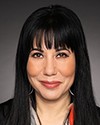Good morning.
First I'd like to thank the Standing Committee on the Status of Women for inviting me to appear as a witness for its study of breast cancer screening for women aged 40 to 49.
I am a professor and cancer biologist at McMaster University. I'm a 15-year breast cancer survivor myself and a member of the research subcommittee of The Olive Branch of Hope Cancer Support Services, or TOBOH.
I have been partnering with TOBOH for the past decade to organize and host “Think Beyond 'Love Pink' Breast Cancer Awareness” education workshops and symposia specifically for Black and other racialized women who consider a breast cancer diagnosis to be a curse or stigma. TOBOH's mission is to tackle this stigma head-on, since knowledge is power and we know that an early diagnosis of breast cancer correlates with good survival outcomes.
Due to advancements in early detection, screening programs and treatment options, breast cancer mortality rates have actually declined almost 50% in the past four decades, from 42 deaths to 22 deaths per 100,000 people. However, epidemiological data continues to describe cancer disparities among racialized Canadian females, which contribute to overt inequities in lived experience during the cancer care continuum and in survival outcomes.
I just celebrated my 25th anniversary as a professor at McMaster. For the first decade of my career, my team was focused on characterizing a novel transcription factor that I discovered and named “Kaiso”.
As it turns out, Kaiso is implicated in many aggressive human cancers, including breast, prostate, lung and pancreatic, but more importantly, we recently reported that Kaiso levels correlate with disparities in breast and prostate cancer outcomes in Black women and men respectively.
In 2008, I heard for the first time about the aggressive triple-negative breast cancer, or TNBC subtype, that was disproportionately affecting young premenopausal African-American and West African women compared to white women.
Currently, most studies and data about breast cancer and triple-negative breast cancer in Black women are based on U.S. data. As a Black Caribbean woman, I was intrigued by these studies. In 2011, during my second research leave, I began studying TNBC in Caribbean and West African women, since there was no published literature about triple-negative breast cancer in the Caribbean or Canada, and Canadian hospitals were not collecting disaggregated demographic data for cancer or any disease.
My research team is specifically interested in determining if there's an ancestral genetic predisposition or susceptibility to triple-negative breast cancer in women of African ancestry. The TNBC prevalence in West Africa ranges from 40% to 70% in Ghana and Nigeria. It ranges from 20% to 22% in the Caribbean and the U.S., but prevalence is only 10% among white women in the U.S.A., suggesting that this could be something inherited from our ancestral slaves from the transatlantic slave trade.
What is most concerning, however, about breast cancer in Black women is that despite having a lower incidence of breast cancer compared to white women, Black women have the highest mortality rate from breast cancer. Black women under age 50 have twice the mortality rate compared to white women. This is possibly due to the fact that there are no targeted therapies for triple-negative breast cancer, which is most prevalent in Black women.
In contrast, white women tend to be diagnosed with estrogen receptor-positive breast tumours, which are effectively treated with the drug tamoxifen.
Because there are no targeted or specific therapies or drugs to treat triple-negative breast cancer, any woman—be they indigenous, Black, Latina, Asian or any other ethnicity—diagnosed with triple-negative breast cancer has a poor prognosis, because they can only be treated with radiation therapy, which targets the breast itself, and standard chemotherapy, which affects all proliferating cells in the body, such as our hair and intestinal cells.
Earlier this month, we were excited to read a published article by Wilkinson and colleagues from the University of Ottawa, which was the first study of breast cancer incidence and mortality by age, stage, molecular subtypes, race and ethnicity in Canada. They reported that compared to white women, other Canadian women had an earlier peak age of breast cancer diagnoses, and more cases were diagnosed under the age of 40. They also reported that Black women have statistically more breast cancer diagnoses at stages 3 and 4 combined, at 26%, versus 17% for white women.
Notably, the proportion of aggressive triple-negative breast cancers among Canadian Black women was twice that of white women, with 20% versus 9.5%. It is a statistic that is very similar to the U.S. data comparing African-American women to white American women.
Wilkinson and colleagues concluded that “Initiation of [breast cancer] screening at age 50 would likely disadvantage women who have greater proportions of BC diagnosed [before the age of 40] and may partially explain the higher proportions of advanced BC cancer diagnoses]...among many younger women of race and ethnicities other than White in this study.”
One size does not fit all, and on behalf of The Olive Branch of Hope, Black Canadian and other racialized women, I urge the Canadian task force on breast cancer screening and the Standing Committee on the Status of Women to consider revising the recommendations to account for populations that are at risk for early onset and aggressive breast cancer subtypes.
I would also like to say that I concur and agree with Dr. Caron, who has pointed out that the criteria for being classified as high risk do not consider the lived experience of marginalized communities in Canada.
Thank you.



